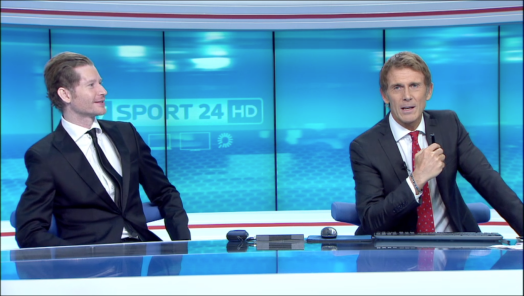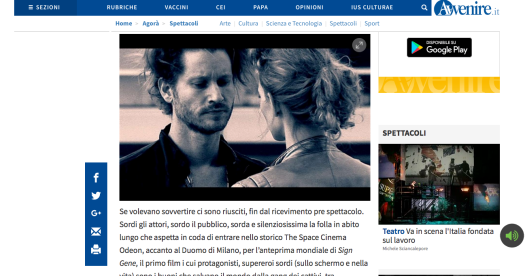TRANSCRIPT
(TRANSLATION FROM ITALIAN TO ENGLISH MADE BY GOOGLE TRANSLATE. WORK IN PROGRESS)
There is a movie titled “Sign Gene” that means the gene of the signs more or less to understand us is a story of superheroes who they get it, I do it very simply because I have to explain in five minutes what would take an hour to be explained, superheroes that draw theirs powers precisely because they are deaf. Emilio and Carola Insolera, are here like, good morning guys, obviously deaf, and our interpreter Romina Rossi, who seems to me, is already very comfortable with sign language. The theme, dear friends from home, dear Michele Plastino and dear Carlo Genta, that is obviously the signs associated with the the world of sport, but first we have to start from telling myself exactly that is good and Romina, that is precisely the sign language that makes you say it makes you acquire super powers that you would not otherwise have in this movie.
Emilio: Yes, absolutely yes, there are many characters in the movie that have a genetic mutation. There is therefore a genetic mutation when you use the sign language more power otherwise you do not have it. In fact we deaf people have great power thanks to the sign language, the visual language.
Stefano: It seems to me, among other things, the first thing I do comes to mind is a great method to make a very international film because if you do not need to talk, the film is immediately devoted to the world market.
Emilio: Yes and no, we must remember that the sign language is not universal in all the nations of the world. To simplify, in fact, there is the sound language and visual language. We have English, Italian, Spanish and so also in sign language, visual language, in English, Italian, Spanish, in other words there is the visual Spanish, the visual German, and so on that we call it the sign language, each one of his own.
Stefano: And Carola, you can tell the story of the film to the division of the roles or who does what movie. Carola: I, it’s the first time I’m part of such a movie and this movie is a very moving movie that gives us the chance to really follow a lot of emotions and then use the other sign language in movies when you have never used it.
Stefano: I am absolutely fascinated by all this because you will understand that well it is an experiment our assent that of course is the first time that we are attracting hearing people in the studio I’m really interested in knowing how it is casting, ie based on which criterion the actors were chosen even though they are all deaf.
Emilio: Yes, they are all deaf people or people who are born from families of deaf people so that they have as their first language the sign language that they have the language of the mother tongue of the signs. There are no agencies for deaf actors so I had to create my network so drawing on what is the my network at international level, from Japan, America to Italy, choosing from people. I found some people who really could do it
this movie together with me. Among other things, one of the actors is one wrestling champion. Stefano: In the sport, I ask Carola, but then he will tell me too Emilio, sport, sports deafness is not considered a handicap and probably right here we enter our field, actually not there is no problem. Carola: All deaf people can do one sports, any kind of sport, they can not just feel, then Absolutely yes, they do not have other types of problems than to find of different solutions to be able to hear, perhaps the whistle of the referee or other things through light channels. Stefano: It’s true, Emilio, that he was born
as short film and then became the project of a film. The idea was that short film that then became a film of a traditional duration.
Emilio: Yes, that was just a simple short film then the people who worked with me were so excited that they told me not we really have to create a movie and I started thinking about it and maybe it was right opportunity to do this when I lived in Japan if I had made a short while I would have given much less information so that’s why we are go to all this. Stefano: The movie has in the meantime been seeing of the scenes is nice action is nice to come to say even with a pin of splatter and very very very emotional load makes wide use of technology and not just say. This is a scene that we actually put it down with this one scene is free, we’re in the band not even too protected, ok ok anyway Watching the hour exactly, you hear Carlo Genta but examples come to mind in the sports of characters that may have that they are audioled while remaining that the joke you have to give me in some case I want to say goodbye to you first athletes who say of all the sports they would do well to express yourself with the most complete signs Carlo: good good look I give you give it a name but you know you mentioned my passion for basketball first Italian come to mind right away here is this gentleman’s name is Miha Zupan ok class 82 to two meters and 3, deaf from birth plays at levels of Euroleague is a good player of Euroleague player of the Slovenian national and so this is the classic example of the first exit of the deafness that is not considered a handicap in the totally deaf sport excellent professional basketball player I think it’s worth the more this picture plus these images of many other words I do not Stefano absolutely amongst other things I also mention a tennis player and I go to Michele
Stefano: Plastino, who is called from there, in short, went to all newspapers lately he has touched the qualification right in the slam we open Michele the sign language no that
they use the people who have to do it, namely the audiolese peopledeaf but in fact then in sports is a truly universal language because double the tennis players make the signs behind their back in tennis in the bubbles it is absolutely natural to make signs there too to agree on the tactics of playing but it also happens to Michele also in football. Michele: you basketball a About basketball instead Carlo is a music professor when he talks about
basketball at cannes is just the vocalist I have to say it feels the great passion yes even in the in football I have to say also the bari and I have to say when playing cards are masters in this but in football mostly corner kickings they call it
Schemes with numbers 1 2 3 free kick soccer I intuisce very much to kick at 5 when I trained right at the dawn of the football federation already practice so I suppose even now where few players are in the action when they do not know how they have to
move amongst other things I was listening with great passion rightly if I did allow the cinematic discourse being passionate I like the full house of great passionate and cinematic acquaintance in the film which proportion is between the signs, that is, the language of the notorious marks is the vocal one that is, what other protagonists are present in the film, that is, if any a relationship … Stefano: a relationship between language of signs and language, conventional word.
Emilio: In the movie, actually, fifty fifty. In the movie there are deaf protagonists who
but there are also some Japanese cops who do not know sign language that they then speak in japanese then speak how to look for these people and so there is a story about people the English language used to tell the story here and at au pair.
It is clear that attention is drawn to the sign language. Stefano: Clear improvement and light practice we talked about before the start of the athletics light is given with an acoustic signal that but it is also a light signal. Emilio: Yes, I think this topic goes
resolved because when you ask a question “can the deaf people do sports?” is in fact you see us are absolutely the same, technology that can help us, as Carola said earlier, technology can help us solve many problems then you said to talk about the deaf language it really is not a language what they use is just a language a language is real with a grammatical structure a syntax that has its own rules while instead the code used to example in other sports it does not know is not made up of phrases and rules
grammar, so you can not talk with that code, philosophy, politics, or else in this topic and this is a theme that it is often used in the hearing world That’s why you create these provisional codes to be able to communicate that they are very limited and when in secret they want to to communicate something and in a language that is not visual and becomes difficult while we can absolutely use the sign language surely we can use much larger and really secret codes change them in every game so nobody can find out.
Stefano: Yes, you hear Romina Rossi, a deaf person how long it takes for you
learn an acceptable sign language?
Emilio: I personally recommend to all hearing people, the Italian people of thinking about our school within our schools should be the sign language should be inserted
because they can have a sound language and a visual language or that the Italian and
it’s not just a language for hearing people but it’s also visual then too for deaf people. Okay, I repeat the concept. Italian is not a sound-only language, is also a visual language. Okay so I think in all Italy should be taught the language of the signs from the beginning for the audience. Now learn the language of the signs, it takes time. Of course, you can learn a sign language at baseline. Of course, I can not answer. Five years still believe. Carola you meant something. How long does it take to learn? Very much because it starts from scratch she is not basically that language so a lot of time because you have to be bilingual so you have to start from the beginning. Emilio: Maybe Carola knows that who wants to tell you is also finding the way you can talk the accent not use the visual king accent must be perfect from small to you today you can learn the language of the signs in six months a year and you will not have all the accents of the case so you will not have all the correct accents up there I would not be so detailed and so is so precise. Stefano: Of course guys here it would be a deepening of two-month course of semiotics Much more we tried to give a clear picture of the situation I would say that one of the best systems we can do to approach this the theme is to go see the movie. Do you meet then when he’s been out in the “Sign Gene” halls? Emilio: This Friday, September 14, in all the UCI Cinemas Italian theaters. In all UCI Cinemas theatres since September 14 Sign Gene, Emilio and Carola He also lacks thanks to Romina. Emilio: For now, 14 are a day and then we can continue if they come to see us. Stefano: We wish obviously going a long way forward is the fundamental thing that must be clear which is obviously a movie made by the blind but evidently I hope it is understand they can look at it all and have to look at it all because you do they understand so many things all and what he said better before that is, in short, the concept is that the music cimito you music subtitle the sign of much action but also very decisive as we have seen from the trailers, thank you guys thank you for being with us.







































